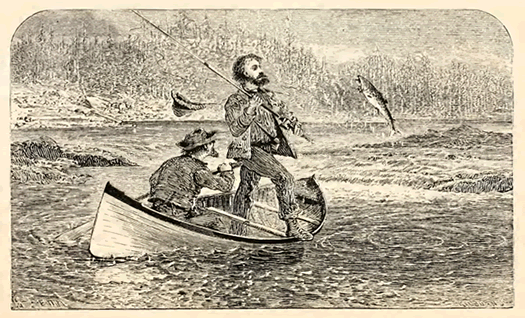"The birthplace of the American vacation"

An illustration from Adventures in the wilderness, or Camp-life in the Adirondacks.
There are a lot of interesting bits in this Smithsonian article about the history of the Adirondacks as a vacation destination -- specifically the influence of Adventures in the wilderness, or Camp-life in the Adirondacks, an 1869 book by William H.H. Murray that helped popularize the idea of vacationing in nature. And after a rough start (unprepared city people heading into the wilderness), the idea took off:
The Adirondacks were soon booming. By 1875, some 200 hotels and camps were operating in the mountains, with new stagecoach services rattling from the train stations and steamboats plying the lakes. By 1900, the Adirondacks' summer population had risen to around 25,000 from 3,000 in 1869. Attracted by the fishing and hunting but appalled by the crowds, the Vanderbilts, Rockefellers, Carnegies, Huntingtons and other fabulously wealthy industrialists built their own spectacular "great camps," where they could disport with their families in private luxury. The American vacation was born--quite literally. The scions of New York City took to declaring that they would "vacate" their city homes for their lakeside summer retreats, and the term "vacation" replaced the British "holiday" in common parlance. As fellow Bostonian Wendell Phillips put it, Murray's book had "kindled a thousand campfires and taught a thousand pens how to write of nature."
The article's author, Tony Perrottet, details the history of some of the great camps, and then visits some of the spots mentioned by Murray.
Murray's book -- a combination guide book/travelogue/ode to the outdoors -- is available in online archives. Skimming through it, he is both enthusiastic about the wonders of nature... and perhaps a bit understated about its complications. A section about bears is after the jump.
Black bears abound in some localities, but more timid, harmless creatures do not exist, all the old stories to the contrary notwithstanding. In temper and action toward men they resemble very closely the woodchuck. Their first and only anxiety is to escape man's presence. If you penetrate far enough into the wilderness, you will occasionally, at night, hear them nosing around your camp, with hedgehogs and the like, but ever careful to keep out of your sight. A stick, piece of bark, or tin plate shied in the direction of the noise, will scatter them like cats. The same is true of wolves. They are only too anxious to keep out of your sight and hearing. Touch a match to an old stump, and in two hours there will not be a wolf within ten miles o fyou. I wish all to take the statement as in every sense true, when I declare that there is absolutely no danger, nor indeed the least approach to danger, in camping in the wilderness. Many and many a night has my wife, when John and I were off on a hunt, slept soundly and without a thought of danger, in the depths of the forest, fifty miles from even a hunter's cabin. It is true that her education in woodcraft is more extensive than that of most ladies, and, for presence of mind, quickness and skill with the rifle, many so-called "crack shots " might well take lessons of her; but were this not true, I regard a camp, granted only that it be so far in that men cannot reach it, as a place of absolute security.
You know, they're like woodchucks.
[via @BrendanScott]
illustration from Adventures in the wilderness, or, Camp-life in the Adirondacks (1869) via archive.org
Hi there. Comments have been closed for this item. Still have something to say? Contact us.
Comments
There are hedgehogs in the Adirondacks?
... said Azurecobalt on Apr 11, 2013 at 6:37 PM | link
Having encountedred dozens of bears, his description is far more accurate than most might believe. Wolves maybe not so much.
... said Chris on Apr 12, 2013 at 9:04 AM | link